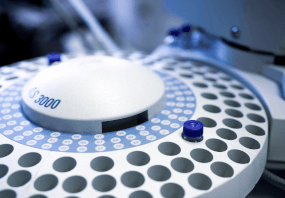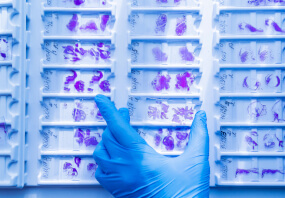General description
HSF1, also known as Heat shock factor protein 1 (HSF-1) or Heat shock transcription factor 1 (HSTF-1), and encoded by the gene HSF1/HSTF1, is a DNA binding transcription factor that binds heat shock promoter elements (HSE’s) and activates transcription. In higher eukaryotes, HSF1 is unable to bind to HSE regions unless the cells are heat shocked. HSF1 is normally a monomer that interacts with HSP90 and other chaperones in a large complex in the cytoplasm. Upon heat shock HSF1 is released from the complex, dimerizes, and is transported into the nucleus. HSF1 is localized to the cytoplasm during normal growth the protein localizes to the nucleus upon heat shock. HSF1 is part of the cellular stress response, and HSF1 is known to interact with many other stress- induced proteins including NCOA6, SYMPK, RALBP1, HSF2, CEBPB, HSPA1A, Heat shock protein 90kDa alpha and HSPA.
Immunogen
Recombinant protein corresponding to mouse HSF 1.
Application
Anti-HSF 1 antibody is an antibody against HSF 1 for use in western blotting, IP & ChIP.
Immunoprecipitation Analysis: A representative lot from an independent laboratory immunoprecipitated HSF 1 from HEK293 cell lysates transfected with wild type or mutant hRP1-HA (Fujimoto, M., et al. (2012). Mol Cell. 48(2):182-194.).
Immunoprecipitation Analysis: A representative lot from an independent laboratory immunoprecipitated HSF 1 from hHSF1 transfected MEF cell lysate (Fujimoto, M., et al. (2010). Mol Cell Biol. 21(1):106-116.).
Chromatin Immunoprecipitation Analysis: A representative lot from an independent laboratory immunoprecipitated HSF 1 from wild type and HSF2-null primary MEF cell lysates (Shinkawa, T., et al. (2011). Mol Cell Biol. 22(19):3571-3583.).
Chromatin Immunoprecipitation Analysis: A representative lot from an independent laboratory immunoprecipitated HSF 1 from HeLa and MEF cell lysates which were either untreated or heat shock treated (Prof. A. Nakai, Yamaguchi University School of Medicine).
Research Category
Epigenetics & Nuclear Function
Research Sub Category
Transcription Factors
Quality
Evaluated by Western Blotting in HeLa cell lysate.
Western Blotting: A 1:1,000 dilution of this antibody detected HSF 1 in 10 µg of HeLa cell lysate.
Target description
~75 kDa observed. Uncharacterized band(s) may be observed in some cell lysates.
Physical form
Rabbit polyclonal serum containing 0.05% sodium azide.
Unpurified
Storage and Stability
Stable for 1 year at -20°C from date of receipt.
Handling Recommendations: Upon receipt and prior to removing the cap, centrifuge the vial and gently mix the solution. Aliquot into microcentrifuge tubes and store at -20°C. Avoid repeated freeze/thaw cycles, which may damage IgG and affect product performance.
Disclaimer
Unless otherwise stated in our catalog or other company documentation accompanying the product(s), our products are intended for research use only and are not to be used for any other purpose, which includes but is not limited to, unauthorized commercial uses, in vitro diagnostic uses, ex vivo or in vivo therapeutic uses or any type of consumption or application to humans or animals.
biological source: rabbit. Quality Level: 100. antibody form: serum. antibody product type: primary antibodies. clone: polyclonal. species reactivity: human, mouse. technique(s): ChIP: suitable, immunoprecipitation (IP): suitable, western blot: suitable. NCBI accession no.: NP_032322. UniProt accession no.: P38532. shipped in: wet ice. target post-translational modification: unmodified. Gene Information: human ... HSF1(3297). Storage Class Code: 10 - Combustible liquids. WGK: WGK 1.Shipping Information:
Dry Ice Surcharge & Ice Pack Shipments: $40
More Information: https://cenmed.com/shipping-returns
- UPC:
- 51314317
- Condition:
- New
- Availability:
- 3-5 Days
- Weight:
- 1.00 Ounces
- HazmatClass:
- No
- MPN:
- ABE1044
- Temperature Control Device:
- Yes












